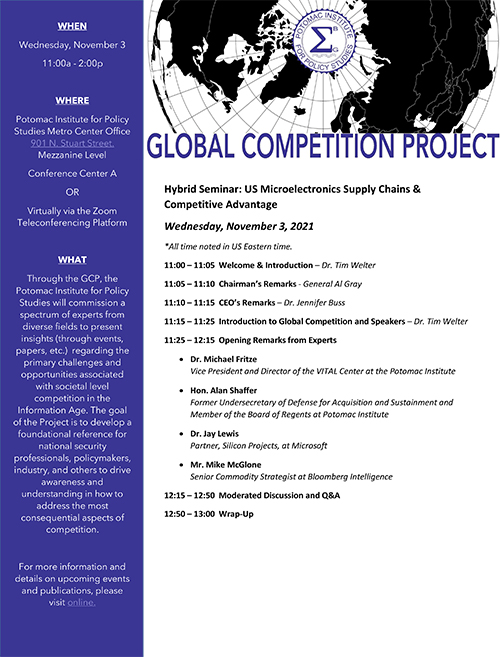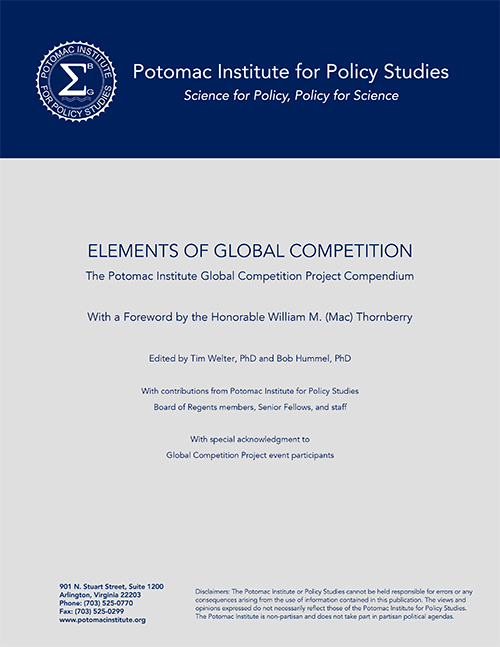November 3, 2021
The headlines are plentiful with stories of serious supply chain issues that have erupted during the COVID-19 pandemic; disruptions and shortages have affected virtually every household in the country, bringing to light just how dependent Americans are on the global supply chain system and vulnerable to its shortfalls. Lack of product and increasing prices have impacted every American, from CEOs to line workers and even school children. The situation has spurred a substantial public dialog regarding the implications of our supply chain vulnerabilities and what they mean for future U.S. prosperity and security.
On November 3, 2021, the Potomac Institute for Policy Studies hosted an event focused on this challenge as part of its Global Competition Project (GCP) series. A panel of subject matter experts examined the state of U.S. supply chains and how they factor into our nation’s ability to gain and maintain competitive advantages on the global stage. Specific attention was paid to the state of microelectronic supply chains due to its key role in both the economic prosperity and national security of the country. Dr. Michael Fritze, Vice President at the Potomac Institute, facilitated the discussion of panel members which also included the Honorable Alan R. Shaffer, former Deputy Undersecretary of Defense and Potomac Institute Board of Regents member; Dr. Jay Lewis, Partner, Silicon Projects at Microsoft; and Mr. Mike McGlone, Senior Commodity Strategist at Bloomberg Intelligence.
Dr. Mike Fritze:
Opening remarks based on a paper he is writing for the GCP, focused on the Balance of Efficiency & Security in Microelectronic Supply Chains: In times of crisis (such as the COVID-19 pandemic), the significance of securing critical supply chains to uphold national security and economic prosperity becomes evident. If during the last 18-24 months you tried to remodel or build a house, bought a car or holiday gift, you likely experienced the impact of supply chain disruption personally. While disruptions associated with the COVID-19 pandemic may be short-term in duration and effect, they nonetheless brought to the forefront serious underlying supply chain issues, especially in the microelectronics space, that have existed for quite some time. Those vulnerabilities, due in part to the rapid commercialization of microelectronics and the resulting free market incentives that drive modern supply chain strategies, if unaddressed, could have debilitating long-term consequences for the U.S.
The U.S. defense enterprise was largely responsible for the development and advancement of microelectronics technologies when they first emerged. As those technologies proliferated into the commercial sector however, private industry rather than the Department of Defense (DoD) became the primary player in their advancement. Additionally, considerable parts of the industry’s supply chains, to include large swaths of manufacturing and its respective labor force, moved overseas. Presently, semiconductor fabrication is dominated by Asian firms and nearly all advanced packaging and testing capabilities reside in Asia as well—a geopolitically challenging region. In addition to the commercialization and globalization of microelectronics, incentives driving supply chain strategies changed from being based on security to that of financial efficiency. Shallow inventories are now the norm, based on “just-in-time” supply strategies which dictate how modern microelectronics supply chains operate. While such optimizations make financial sense and normally work quite well, events like the COVID-19 pandemic can cause significant disruptions and be quite destabilizing.
Global supply chain disruptions, like those experienced with the pandemic, highlight why strict reliance on commercial supply chains is a tenuous strategy, especially given the criticality of microelectronics to our nation’s economic prosperity and national security. The DoD must have access to a steady source of microelectronics parts and technologies regardless of the state of the global supply chains due to their importance to military systems and platforms which ultimately translates to the U.S. being able to realize its security needs across the globe.
Ultimately, security needs to be reemphasized in the development of future supply chains, especially those linked to key components like microelectronics. While free market principles and incentives should continue to drive the industry, changes must be made to assure resiliency in times of crisis (like the COVID-19 pandemic). Failure to do so will leave the U.S. vulnerable from a security standpoint and at a competitive disadvantage in global markets.
Hon. Al Shaffer:
U.S. allies and adversaries are heavily subsidizing their domestic microelectronics industries. South Korea recently announced a $450 billion investment in its commercial microelectronic entities over 10-year period, Taiwan is also making a similar sized investment, and perhaps most concerning, the Peoples Republic of China (PRC) announced it will invest $250 billion in domestic microelectronic capabilities. Cleary, there is acknowledgement of the pivotal role of microelectronics in the national security and economic prosperity of these nations in their actions to secure access to domestic supplies. While the U.S. has increased interest to that end, little has been done regarding investment when compared with other nations.
Guaranteed microelectronics access is critical for both U.S. economic prosperity and national security also. Access is needed not just for defense but to secure critical national infrastructure (power grids, financial, healthcare, transportation, etc.). Additionally, if data is to be the “new oil” of future economies (as it has often been referred) then secure access to microelectronic technologies will play a critical role.
In the 1970s, the U.S. could produce roughly 67 percent of its oil needs. However, when the Organization of the Petroleum Exporting Countries (OPEC) placed an oil embargo on the U.S. the economy went into a severe recession. Contrast the U.S. oil production position of the 1970s with its microelectronics position today. Currently, the U.S. uses 48 percent of the world’s microelectronic supply while only manufacturing 12 percent. If data is the economic engine of the future, and data runs on microelectronics, then failure to achieve a secure microelectronic supply could result in potentially crippling disruptions and economic blackmail in the future.
In light of this challenge, incentivizing industry to produce more microelectronics domestically will be vital to securing U.S. semiconductor supply chains. Public-Private-Partnership will be essential to that end and there are variations on how such a partnership might occur. From a policy perspective, incentives may be achieved by expanding the definition of national security to critical infrastructure entities such as the power grid, air traffic control, the energy distribution grid, and the health and finance sectors. If considered together, these entities represent 25 percent of the world’s microelectronics demand, potentially driving market incentives to expand domestic production in the United States. This in turn, would provide a more secure microelectronics supply chain while increasing domestic capacity that will help cushion the impact of crises on the economy.
Ultimately, the U.S. needs to examine the development of its domestic microelectronics industry as an important strategic initiative. If the U.S. continues to approach the issue without a sustainable strategic model that allows for more domestic access to microelectronics, its competitive advantage will lag from both a security and economic perspective.
Dr. Jay Lewis:
The DoD is spending 99 percent of its time caring about one percent of its chips. Prioritization, in terms of national security, is placed on microelectronics specifically made for the DoD while the security and sustainability of commercial chip production receives little attention. High specialization, rad-hard, custom state-of-the-art (SOTA) and state-of-the-practice (SOTP) DoD chips take precedence, in terms of government investment, over older legacy microelectronic technologies. These more mature technologies represent the dominant share of DOD needs and represent where most supply chain disruptions occurred during the COVID-19 pandemic.
Most commercial technologies still use older mature microelectronics parts. While investing and securing DoD custom microelectronics is essential to U.S. national security, it still represents only one percent of the total U.S. microelectronics market share. The remainder fuels the commercial needs of the U.S. economy. Since economic prosperity is essential to U.S. national security, a comprehensive investment model supporting domestic commercial microelectronics is just as much a national security priority as what drives DOD customer needs.
Any investment strategy to secure U.S. domestic microelectronic supply chains without emphasis on commercial market needs will be incomplete; a holistic microelectronics sustainment investment strategy that address both DoD and commercial needs to be understood from an industry and government policy making perspective. Short term investment goals targeted at immediate market needs must be paired with long-term strategic goals if any supply chain security strategy is to be effective in ensuring U.S. global competitiveness in the future.
Mr. Mike McGlone:
In the last major great power competition that the U.S. found itself in, with the USSR, economics were the key force in the latter’s final collapse and the former’s ascendence as the world’s lone hegemonic power. In today’s global competition, economics are playing a similarly important role with U.S.’s current geopolitical rival, the People’s Republic of China (PRC). China has decided to compete with the U.S. primarily in the economic and non-kinetic domains. However, recent data on the state of the PRC economy shows indications of financial deterioration. Declining GDP, cuts to the PRC’s Reserve Requirement Ratio (RRR), and troubles with China’s real estate market all lend doubt as to the PRC’s ability to compete economically with the United States in the long-term. However, perhaps the best indicator for an inevitable Chinese economic decline is its failure in adoption of crypto currencies.
There are important trends occurring in the crypto currency and commodities space that have significant implications to the strength of the U.S. economy as it relates to global competition. The first trend is the rising popularity of the U.S. crypto dollar as a global currency. Countries around the world are adopting U.S. crypto dollars as the primary digital currency for which commodities are traded on. A common misperception is that other digital currencies like Bitcoin or Ethereum a devaluing the U.S. dollar. This is not the case, as evident by the U.S crypto dollars success. What is actually occurring is that the U.S. crypto dollars are becoming the global reserve asset while other digital currencies like Bitcoin are becoming global collateral rapidly taking the place of gold. Bitcoin is a commodity that the PRC has sunk a substantial amount of investment to mine.
Corresponding with the ascendence of the U.S. crypto dollar is its subsequent banning, along with all other crypto currencies, in China. This was done by the PRC in an effort to boost its own central bank digital currency, though with little success, and resulted in their digital currency having no trade value outside the borders of China.
A second trend indicating the resiliency of the U.S. economy is its dominance in two key commodities: energy and agriculture. The U.S. is the world’s largest exporter of energy including liquid fuels (ethanol), natural gas, electricity, and petroleum. The U.S. is also the largest exporter of agriculture products. In fact, the most significant commodity on the planet in terms of dollar value production is corn. The dominant performance of these two commodities in the global marketplace along with the increased movement towards the adoption of the U.S. crypto dollar by large swaths of the global population provide a foundation for long-term U.S. prosperity into the future. Essentially the U.S. produces some of the most sought-after goods on the planet and many people want to trade them using U.S. digital currency. From an economic standpoint, the U.S. should embrace and incentivize these trends by avoiding regulations that could stifle its two biggest potential economic advantages.
When you’re in the middle of a battle and you’re crushing your enemy the most important thing you can do at that point is find a way not to lose. When it comes to competing with the PRC, our best strategy may be to avoid screwing up our current economic advantages by rewarding the creative capacity of individuals who have generated the tools which allowed us to become the nation we are today and provided the means to triumph in past global competitions.
Conclusions & Key Takeaways:
- Supply chain shortages and disruptions stemming from the COVID-19 pandemic brought to light key vulnerabilities and dependencies of the U.S. economy, which if left unaddressed could be detrimental to American prosperity and security.
- The evolution of the microelectronics industry has placed the U.S. at a competitive disadvantage as its primary economic incentives shifted from a focus on domestic security to that of global commercial production efficiency, primarily based in Asia.
- Policymakers and industry need to pursue a holistic approach that balances domestic commercial and security needs, recognizing both require secure, resilient supply chains, as do the security of critical national infrastructure (power grids, financial, healthcare, transportation, etc.).
- Short term investment goals targeted at immediate market needs must be paired with long-term strategic goals for any ME supply chain security strategy if it is to be effective.
- If data is the “new oil” of future economies, secure access to microelectronic technologies will play a critical role in gaining and maintaining an enduring competitive advantage in data-driven markets.
- As a strategic initiative, incentivizing industry to produce more microelectronics domestically will be vital to securing U.S. semiconductor supply chains; leveraging public-private partnership will be essential to the effort.
- Economics are central to gaining advantage in today’s globally competitive environment; China is competing with the U.S. primarily in the economic and non-kinetic domains, but grappling with internal economic challenges (some self-imposed).
- The dominant performance of U.S. energy and agriculture commodities in the global marketplace along with movement toward the global adoption of the U.S. crypto dollar as a crypto reserve currency provide a foundation for long-term U.S. prosperity into the future; consideration for development of policies and incentives to render more resilient, secure supply chains.




 Having worked in the private sector, the military, and on Capitol Hill, Tim Welter brings valuable experience in national security and defense policy to the Institute. After serving on active duty in the Air Force for several years, he worked on Capitol Hill as Legislative Director for two different Members of Congress and later as a Professional Staff Member with the House Veterans Affairs Committee. Upon leaving the Hill, Tim worked with the foreign and defense policy research team at the American Enterprise Institute. He later completed a research fellowship at the National War College during which he finished his Ph.D. dissertation in Political Science with the University of Missouri, writing about the political nature of defense policy in Congress. A U.S. Air Force Academy graduate, Tim holds Master’s degrees in Political Science, National Security Strategy, and Management. Just prior to joining the Institute, Tim served at the Pentagon where he helped stand up an organization dedicated to future force design and the development of capabilities and concepts required to meet to emerging national security challenges.
Having worked in the private sector, the military, and on Capitol Hill, Tim Welter brings valuable experience in national security and defense policy to the Institute. After serving on active duty in the Air Force for several years, he worked on Capitol Hill as Legislative Director for two different Members of Congress and later as a Professional Staff Member with the House Veterans Affairs Committee. Upon leaving the Hill, Tim worked with the foreign and defense policy research team at the American Enterprise Institute. He later completed a research fellowship at the National War College during which he finished his Ph.D. dissertation in Political Science with the University of Missouri, writing about the political nature of defense policy in Congress. A U.S. Air Force Academy graduate, Tim holds Master’s degrees in Political Science, National Security Strategy, and Management. Just prior to joining the Institute, Tim served at the Pentagon where he helped stand up an organization dedicated to future force design and the development of capabilities and concepts required to meet to emerging national security challenges.